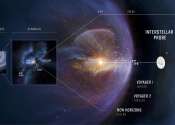Tracing the largest solar storm in modern times from tree rings in Lapland
A research group coordinated by the University of Helsinki was able to measure a spike in radiocarbon concentration of trees in Lapland that occurred after the Carrington flare. This discovery helps to prepare for dangerous ...









